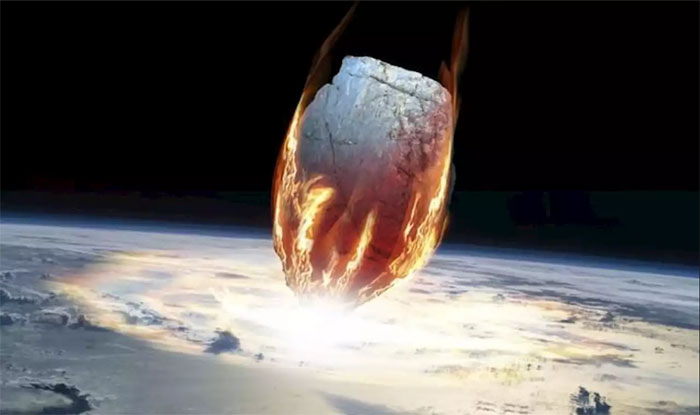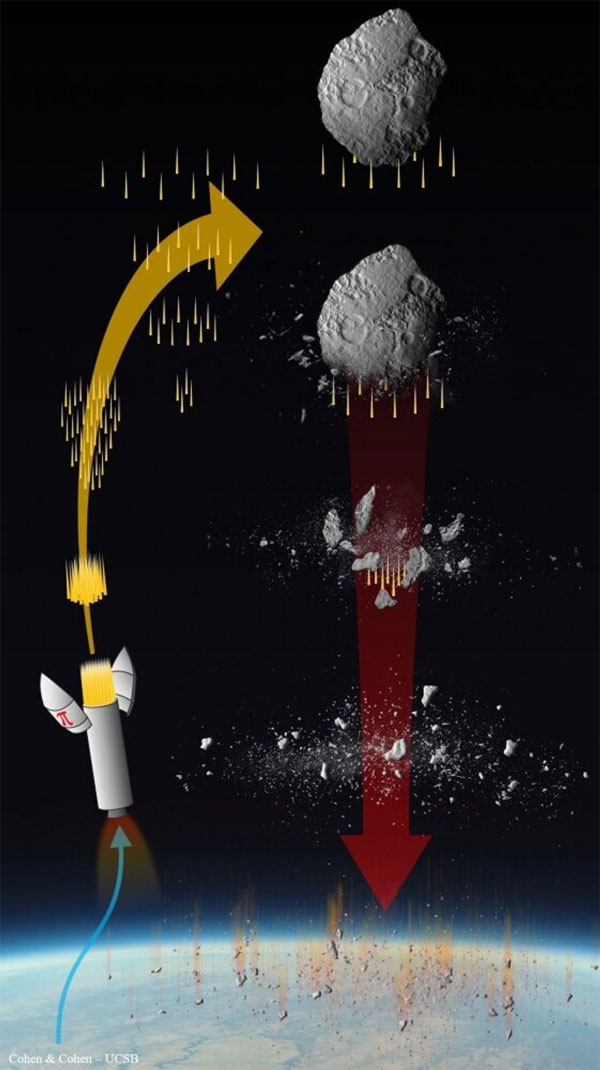With diameters of up to 370 meters and 490 meters, these two objects could pose a significant threat to Earth.
The Giant Asteroids of 2029 and 2036: Exploding with the Power of All Nuclear Weapons on Earth Combined
In February 2013, sky watchers around the world turned their attention to asteroid 2012 DA14, which has a diameter of about 50 meters and was set to pass closer to Earth than the satellites providing our television signals.
What they did not realize was that while they were focused on the asteroid that would take decades to pass by Earth (2012 DA14), another asteroid was barreling directly toward Earth, posing serious consequences.
As a result, on February 15, 2013, an asteroid named Chelyabinsk, with a diameter of 19 meters, exploded above the city of Chelyabinsk in Russia after entering Earth’s atmosphere at a shallow angle. The shockwaves from the explosion shattered windows and damaged buildings, injuring nearly 2,000 people, although fortunately, no one was killed.
Philip Lubin, a physics professor at the University of California, Santa Barbara, and one of the many scientists predicting the closest approach of 2012 DA14, stated: “It turns out there were two completely independent asteroids heading toward Earth at the time we were observing (February 2013).”
For Professor Lubin and other scientists, such incidents underscore the urgent need to protect the planet—detecting, tracking, characterizing, and ultimately defending against potentially dangerous asteroids and comets.

Monitoring is a way to protect against potentially dangerous asteroids and comets for Earth.
Threatening events like the Chelyabinsk asteroid are rare, occurring about once every 50 to 100 years, but they can be devastating. The most recent of these events was the Tunguska event, an aerial explosion in eastern Siberia (Russia) in 1908 that flattened hundreds of square kilometers of forest.
Less common, but still possible, are objects that threaten mass extinction, such as the super Chicxulub meteor, which wiped out the dinosaurs about 66 million years ago, or the airburst event 12,800 years ago that triggered widespread fires and initiated an “impact winter” known as the Younger Dryas.
The challenge for scientists is that they cannot predict accurately but only relatively the timing and trajectory of asteroids heading toward Earth. For instance, asteroid Apophis, with a diameter of 370 meters, is expected to fly past our planet on Friday, April 13, 2029. Meanwhile, the massive asteroid Bennu (490 meters in diameter) is forecasted to make a similar approach in 2036.
Professor Lubin warns: “The actual danger level of the giant asteroids Apophis and Bennu is extremely serious. If they were to strike Earth, just one of them (either Apophis or Bennu) would possess the power equivalent to all the nuclear weapons on Earth combined. Imagine the horrific scenario: All of Earth’s nuclear arsenal would be detonated within seconds—then you would understand how catastrophic that disaster would be. So, how can we prevent this scenario?”
According to data from the British Encyclopedia, the United States, Russia, and China are the three countries with the most nuclear weapons in the world.
- Regarding the United States: The U.S. nuclear arsenal peaked in 1966, with over 32,000 warheads of 30 different types. By 2010, the U.S. had about 9,400 warheads of 9 types of weapons: including 2 types of bombs, 3 types for intercontinental ballistic missiles (ICBMs), 2 types for submarine-launched ballistic missiles (SLBMs), and 2 types for cruise missiles.
- As for Russia’s nuclear arsenal: The Soviet Union’s nuclear stockpile peaked in 1988 with about 33,000 operational warheads [not counting an additional 10,000 warheads that were previously deployed but have since been retired and not dismantled].
- Third is China: China’s nuclear arsenal remained relatively stable throughout the 1990s and then began to increase in the early 21st century. By 2010, China had about 240 warheads, of which around 180 were operational, while the remainder were in reserve or retired.
- Other countries that also possess nuclear weapons include Israel, India, Pakistan, and North Korea. Israel maintains an undisclosed nuclear stockpile of between 60 to 80 warheads, but all developments are kept secret.
- India is estimated to have between 60 to 80 assembled warheads, while Pakistan has approximately 70 to 90 nuclear warheads. [Most nuclear warheads in India and Pakistan are believed to be non-operational].
- North Korea, which joined the nuclear club in 2006, may have produced enough plutonium by 2010 for 8 to 12 warheads, although it is unclear how many of these are operational.
Thus, the world’s nuclear arsenal (including both operational and retired weapons) could amount to tens of thousands of different types. And combined, they would only equal the destructive power of asteroid Apophis or Bennu alone.
Although these two massive asteroids are not predicted to collide with Earth, even relatively small changes in their trajectories could cause them to impact Earth. And that is what worries scientists the most. The risk comes from external factors.
So, what should humanity do to proactively protect itself?
Planetary protection strategies have evolved from studying better methods to understand threats to efforts to deflect potential hazards and alter their orbits. This includes a strategy developed by Professor Lubin’s team, proposing the use of lasers to push threatening objects away from Earth.
In two papers on the topic of protecting the planet from meteors and asteroids submitted to the journal Advances in Space Research (part of the International Council for Science (ICSU)), and the journal Scientific American, Professor Lubin and co-author Alexander Cohen proposed a more proactive method to deal with dangerous space debris beyond Earth. The project is called PI, short for Pulverize It.
Preparing for the “inevitable” – to be or not to be?
“If we say that nothing is certain except death, it may not be complete. We need to add human extinction due to meteors to this list. In the vast Solar System, there is always a large asteroid or comet lurking somewhere. What we don’t know is where it is or when it will strike us.” – Professor Lubin wrote.
In just the past 113 years, Earth has been ‘attacked’ by 2 large asteroids that could threaten the lives of millions if they ‘attacked’ a major city. However, humanity has been fortunate!

The key to the PI strategy is deploying a series of penetrators. (Credit: Alexander Cohen).
Researchers say that in light of this very real threat, it is time to seriously plan and implement a planetary protection program. PI allows for a reasonable and cost-effective approach to the ultimate planetary protection program.
The key to the PI strategy is deploying a series of penetrators (shaped like a bullet), which can be filled with explosives. The penetrators—ranging in diameter from 10 to 30 cm and 2 to 3 meters long—are tasked with fragmenting the asteroid or comet when they collide with it at high speed.
Researchers state that instead of deflecting the object, the strategy is to allow Earth to ‘take the hit,’ but first fragment the asteroid into smaller pieces—often the size of a house—and let those fragments enter Earth’s atmosphere.
The rest is up to the atmosphere. As they plunge into our atmosphere, it can absorb the energy of the asteroid and continue to vaporize them while causing massive friction that ignites them in mid-air. The smaller remnants will fall to Earth—causing no significant disaster.
“If you can reduce large, dangerous events into a series of small, harmless events, then you can mitigate the larger threat,” co-author Alexander Cohen stated.
According to calculations by physicists, smaller targets such as the Chelyabinsk meteor can be intercepted just minutes before colliding with Earth using much smaller launch platforms—similar to ICBM interceptors—while more serious threats, like the 370-meter-wide asteroid Apophis, may need to be intercepted up to 10 days before impact.
Attack is the Best Form of Defense
Researchers indicate that another part of the PI program is to consider a proactive approach to protect our planet.
Professor Lubin states: “We vaccinate to prevent future diseases. Therefore, nothing should stop us from vaccinating this planet using ‘giant bullets’ like vaccine syringes to prevent future extinction-level disasters from asteroids.”
With this approach, the same system could be used to proactively eliminate threatening objects like Apophis and Bennu to safeguard future generations.
According to Professor Lubin and Cohen, this new approach could make planetary defense quite feasible and “as easy as PI,” while also allowing for the creation of a reasonable pathway for a robust planetary defense system.
“Humanity could ultimately control its destiny and prevent a future mass extinction disaster,” the researchers write.
The research in this project is also conducted by scientists Jeeya Khetia, Tegan Costa, Hannah Shabtian, Dharv Patel, Alok Thakrar, Alex Korn, and Kellan Colburn.


















































